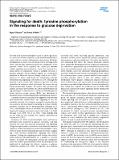Signaling for death: tyrosine phosphorylation in the response to glucose deprivation
Author(s)
Bryson, Bryan D.; White, Forest M.
DownloadBryson-2012-Signaling for death.pdf (308.3Kb)
PUBLISHER_CC
Publisher with Creative Commons License
Creative Commons Attribution
Terms of use
Metadata
Show full item recordAbstract
The shift from oxidative phosphorylation to aerobic glycolysis in cancer has focused attention on the altered metabolism of cancer cells as a means of therapeutic intervention. Metabolic dysregulation in cancer was first proposed by Warburg in the 1930s, and this topic remains an active area of research. While previous studies have explored the connection between cellular signaling and metabolism, many have focused on a small subset of components within a complex network of proteins, enzymes, and biochemical signals. In a recent article published in Molecular Systems Biology, Graham et al (2012) endeavor to better understand the relationship between metabolism and signaling at the network level. Although the question of how cancer cells respond to glucose starvation posited by the authors is relatively simple, the answer ends up being unexpectedly complex. To answer this question, the authors use mass spectrometry and other biochemical profiling techniques to demonstrate a connection between glucose levels, reactive oxygen species (ROS), and alterations in phosphotyrosine-mediated signaling in glioblastoma cell lines.
Date issued
2012-06Department
Koch Institute for Integrative Cancer Research at MIT; Koch Institute for Integrative Cancer Research at MITJournal
Molecular Systems Biology
Publisher
Nature Publishing Group
Citation
Bryson, Bryan D, and Forest M White. “Signaling for Death: Tyrosine Phosphorylation in the Response to Glucose Deprivation.” Molecular Systems Biology 8 (2012).
Version: Final published version
ISSN
1744-4292